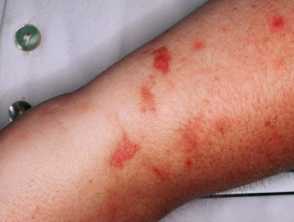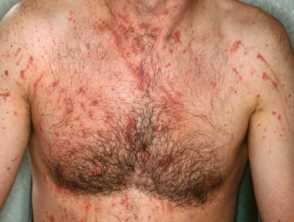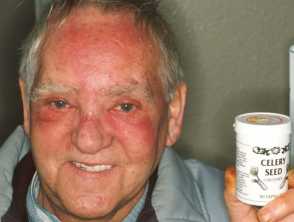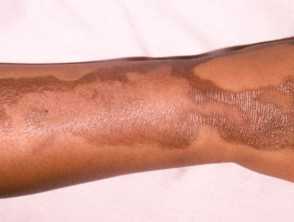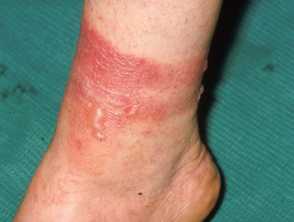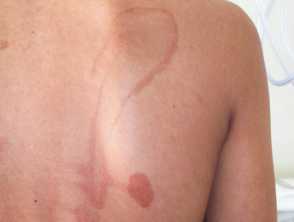What is phytophotodermatitis?
Phytophotodermatitis, a form of plant dermatitis, is a skin reaction that occurs after natural photosensitising chemicals (furanocoumarins) present within plant sap and fruits, become smeared onto the skin, and there is subsequent exposure to sunlight.
The areas affected become acutely red, and often blister. Skin lesions may be linear or streaked in morphology. After the acute inflammatory reaction subsides, there is typically postinflammatory hyperpigmentation which may last for years.
Who gets phytophotodermatitis?
Phytophotodermatitis can develop in anyone. It is not an allergy, and accidental contamination of the skin with the juice or sap from a causative plant, followed by sun exposure, may induce the reaction.
Individuals at greater risk include:
- Vegetable pickers
- Hikers and walkers who accidentally brush past plants
- Children may make pea shooters from the stems of plants and contaminate their lips
- Bartenders eg, lime juice exposure
- Gardeners
- Those using “strimmers” (brush cutters, weed or string trimmers).
What causes phytophotodermatitis?
Many plants contain furanocoumarins, which are responsible for the acute phototoxic reactions. Ultraviolet A radiation (UVA) interacts with the furanocoumarin, producing cell membrane damage and inflammation.
Local accidental smearing of plant sap onto the skin followed by light exposure is the most common type of reaction; ingestion of plants rich in furanocoumarins cause a more generalised photosensitivity. The reaction is a direct toxic effect and does not involve the immune system.
Table 1. Common causative plants
| Botanical name | Common names | |
| Umbelliferae | Ammi majus | Queen Anne's Lace |
| Heracleum spondylium | Cow parsnip | |
| Heracleum mantegazzianum | Giant hogweed | |
| Pastinaca sativa | Parsnip | |
| Apium graveolens | Celery | |
| Rutaceae |
Citrus bergamia |
|
|
Dictamnus albus |
Gas plant, burning bush of Moses |
|
| Moracea | Ficus carica | Fig (from sap, not fruit) |
What are the clinical features of phytophotodermatitis?
Approximately 24-48 hours, after exposure to ultraviolet radiation from sunlight, the area of skin contaminated by the photosensitising sap/juice becomes red, inflamed, and often blisters. Ulceration may occur, the area will scale, and then heal after several weeks to leave postinflammatory pigmentation, which may last for several years.
There are several possible patterns of reactions:
- Linear streaks on the exposed areas of skin, particularly limbs
- Drip shaped lesions on the arms (eg, lime juice exposure)
- Round lesions on the lips from using a plant pea shooter
- Spatters and streaks on the face and torso from using a string trimmer
- Redness and swelling on the exposed sites of the face, hands, and arms after eating large amounts of furocoumarin-containing foods
- Redness from use of botanical / herbal cosmetics on the exposed skin where they have been applied
- Lesions on the hands and fingers, especially in vegetable pickers (parsley, parsnip, and celery).
How do clinical features vary in differing types of skin?
Postinflammatory hyperpigmentation may be more intense in skin of colour.
What are the complications of phytophotodermatitis?
- Blistering
- Ulceration
- Infection
- Postinflammatory hyperpigmentation
- Scarring
How is phytophotodermatitis diagnosed?
The history of accidental exposure to causative plants combined with the clinical appearance is diagnostic.
What is the differential diagnosis for phytophotodermatitis?
- Allergic contact dermatitis to plants
- Burns
- Non-accidental injury
- Dermatitis artefacta
- Shiitake flagellate dermatitis
What is the treatment for phytophotodermatitis?
General measures
- Cool compresses
- Topical antiseptics to prevent infection
- Topical steroids
- Analgesia
The use of a sunscreen with high UVA protection in addition to covering the skin to prevent further light exposure may diminish the severity of the reaction if it is commenced as soon as the accidental exposure is recognised.
What is the outcome for phytophotodermatitis?
Provided offending plants can be recognised and avoided, it should not recur. Occupational phytophotodermatitis in vegetable pickers can be avoided by wearing appropriate gloves. Those using “strimmers” should protect themselves using a visor and protective clothing.
